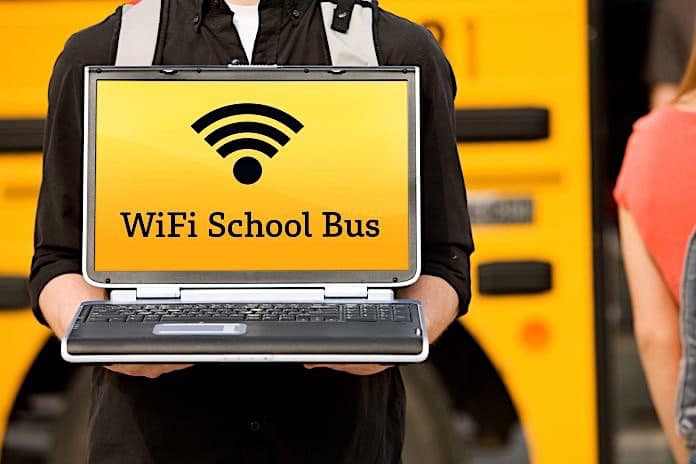School districts and transportation departments that missed the application window to implement school bus Wi-Fi hotspots using the Emergency Connectivity Fund (EFC) have a second chance.
State-by-state breakdown of current funding demand acorrding to FCC:
Alabama: $62,677,788.77
Alaska: $51,874,215.69
American Samoa: $25,333,082.75
Arizona: $200,700,041.70
Arkansas: $29,625,857.99
California: $812,045,890.55
Colorado: $36,571,291.19
Connecticut: $37,089,292.04
Delaware: $8,704,910.69
District of Columbia: $19,874,749.59
Florida: $264,359,207.11
Georgia: $183,225,350.75
Guam: $6,327,126.00
Hawaii: $67,304,321.57
Idaho: $35,155,222.55
Illinois: $197,177,597.95
Indiana: $53,587,049.39
Iowa: $23,005,029.79
Kansas: $24,789,998.78
Kentucky: $54,103,362.53
Louisiana: $72,348,418.89
Maine: $7,672,141.84
Maryland: $53,330,800.91
Massachusetts: $61,436,020.80
Michigan: $108,365,415.67
Minnesota: $62,868,827.25
Mississippi: $21,104,090.16
Missouri: $90,636,490.46
Montana: $4,248,117.07
Nebraska: $21,607,941.17
Nevada: $29,125,668.53
New Hampshire: $5,500,399.98
New Jersey: $225,318,068.42
New Mexico: $67,218,187.36
New York: $559,653,550.51
North Carolina: $149,795,970.80
North Dakota: $3,631,027.80
Northern Mariana Islands: $1,314,000.00
Ohio: $103,412,800.95
Oklahoma: $94,616,613.76
Oregon: $82,187,638.46
Pennsylvania: $99,766,355.39
Puerto Rico: $102,867,340.87
Rhode Island: $15,040,521.71
South Carolina: $27,150,599.18
South Dakota: $6,821,624.05
Tennessee: $44,010,989.51
Texas: $496,488,916.30
U.S. Virgin Islands: $5,016,227.60
Utah: $34,209,445.61
Vermont: $5,048,353.29
Virginia: $62,890,826.34
Washington: $101,244,763.67
West Virginia: $48,189,817.50
Wisconsin: $66,626,909.48
Wyoming: $2,962,578.64Total: $5,137,258,847.31
The Federal Communications Commission (FCC) announced it will open a second round of funds, with the application period opening on Sept. 28 and running through Oct. 13. The additional opportunity is in response to FCC receiving requests for $5.137 billion to fund 9.1 million connected devices and 5.4 million broadband connections as a part of the initial $7.17 billion ECF program.
The first filing window was open for 45-days and closed on Aug. 13. It attracted applications from rural and urban communities in all 50 states and American Samoa, Guam, Northern Mariana Islands, Puerto Rico, Virgin Islands, and the District of Columbia.
The first round of applications funded equipment and services received or delivered between July 1 and June 30, 2022. The second filing window will also be for the current 2021-2022 school year.
Additionally, FCC said it seeks to address applications that were filed after the deadline and the challenge of schools applying during the summer months. “Moreover, the rise of the Delta variant means off-campus connectivity remains vital to ensuring students, school staff, and library patrons can engage in remote learning as they face challenges and uncertainty amidst the ongoing COVID-19 pandemic,” the FCC stated in a recent press release.
Related: FCC Emergency Connectivity Fund Applications Open Soon
Related: FCC Approves School Bus Wi-Fi Hotspots Under COVID-19 Emergency Connectivity Fund
Related: Senate Bill Pushes FCC to Fund School Bus Wi-Fi
Related: Federal Funding Window for School Bus Wi-Fi Hotspots Closing Soon
Related: School Buses Continue New Mission of Delivering Mobile Wi-Fi Hotspots
“The Emergency Connectivity Fund is the single largest effort to bring connectivity and devices to students who lack them — and this robust response from applicants shows the tremendous need in our communities. This funding is an important down payment in closing the homework gap so that all children, regardless of their circumstances or where they live, have access to the tools they need to succeed,” said acting FCC Chairwoman Jessica Rosenworcel. “The pandemic highlighted like never before the difference a reliable internet connection can make in a student’s education, and we want to make sure that as many schools and libraries can apply for support this school year. The need is there, and the opening of a second application window reflects that. Together with the Emergency Broadband Benefit Program, we are investing more than $10 billion in American students and households, so more Americans can connect, communicate, and more fully participate in modern life.”
The second round of funding is available for the purchase of “laptops and tablets, Wi-Fi hotspots, modems, routers, and broadband connections for off-campus use by students, school staff, and library patrons in need, and is available to support off-campus learning, such as homework, even if schools have returned to full-time, in-person instruction,” the FCC concluded.
















